Vineyards in China spread from the picturesque valleys of Yunnan to a fertile oasis in the Gobi Desert. We profile some emerging wine regions and trace the diverse range of grapes proliferating across the Middle Kingdom.
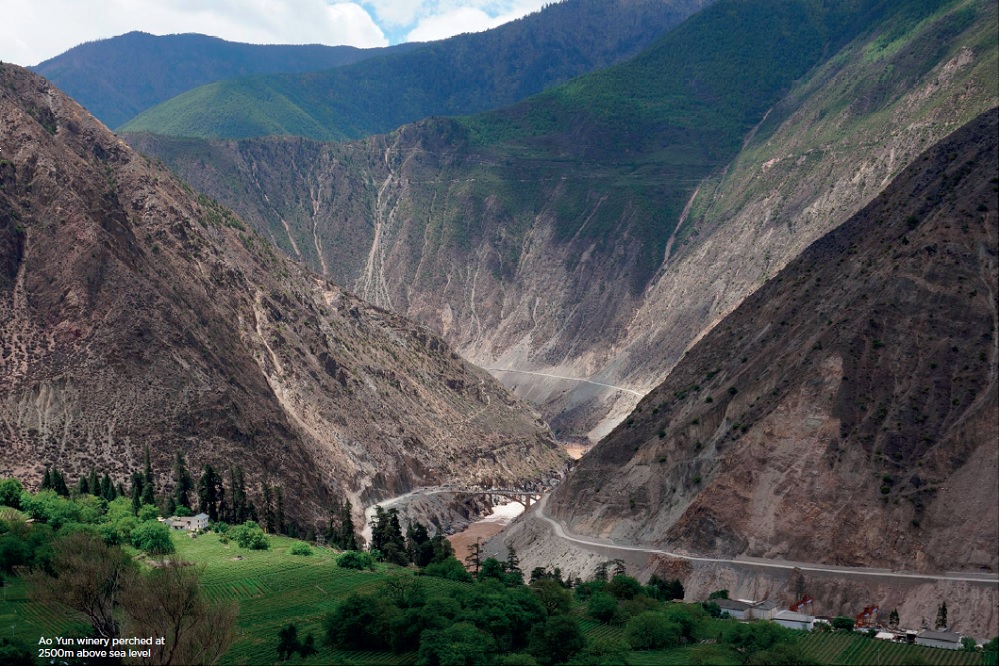
“We are discovering a new terroir,” says Maxence Dulou. As the winemaker and estate director at Ao Yun Estate in Yunnan province, Dulou is keenly aware that he is on new frontiers. “No two years are the same, and we are learning a little bit more every season.”
Translating to “flying above the clouds,” the name Ao Yun is a nod to the winery’s position in the remote spell-binding Mekong valley. The closest city, Shangri-La, is four hours away. The UNESCO-protected region is fed by three parallel rivers, running through steep gorges and surrounded by glaciated peaks more than 6000m high.

The vineyards sit in the villages of Adong, Shuori, Sinong and Zidang, perched up at altitudes of 2200m to 2600m above sea level. Summers are dry as the mountains protect the region from rains, and winters are moderate enough to obviate the unusual tradition of burying vines, as practised in northern China.
“It took us a few years to understand that this is a cool climate site. Cooler than Bordeaux because of the shade of the mountain,” Dulou says. The grapes get 30 percent fewer sunshine hours, although that exposure is intensified by strong ultraviolet rays. Add the cool nights (15 to 20 degrees Celsius cooler), and Dulou has 20 to 25 more ripening days than Bordeaux.
The plantings are scattered across 300-odd patches of land on steeply terraced terrain. “Even if the blocks are very small, there is so much variation inside the same block,” Dulou says. The plots are grouped by their microclimate markers and tended by local Tibetan farmers manually. It’s a mammoth effort that involves 3,500 manhours per year for every hectare.
When it comes to winemaking, altitude plays a key role. With 25 percent less oxygen, Dulou opts for terracotta jars, as used in Baijiu production, to micro-oxygenate the wine. Because altitude alters the sense of taste, he must take the samples to sea level, usually Hong Kong, for the final blending.
Dulou recently launched his 9th vintage, Ao Yun 2017. The wine comprises 72 percent cabernet sauvignon, along with merlot, petit verdot and cabernet franc. He says he is “not making an expression like Bordeaux but an expression of cabernet sauvignon.”
The country’s love for Bordeaux has translated into a sea of cabernet sauvignon, which accounts for 63 percent of the current plantings across China’s major eight winegrowing regions (none as precipitous as Yunnan). Besides cabernet and its natural Bordeaux allies, producers are also growing marselan, cabernet gernitsch, syrah, pinot noir, and more. Among white varietals, which amount to 20 percent of the plantings, chardonnay and Italian riesling are the most popular.
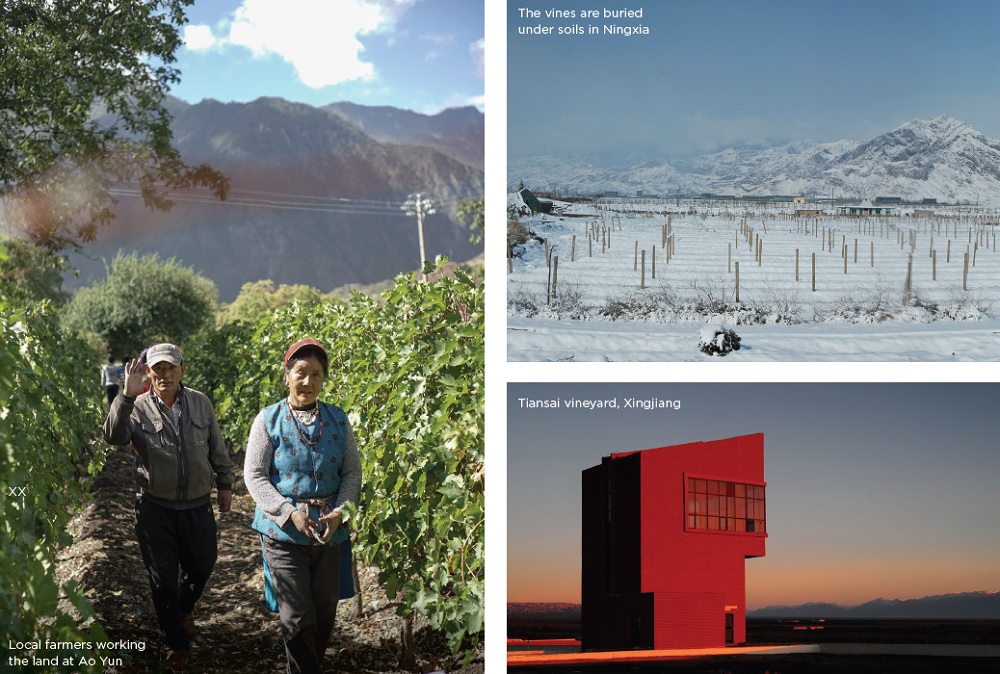
VAST AND ARID NINGXIA
In the north, the economically poor autonomous region of Ningxia has emerged as a winemaking powerhouse, often referred to as China’s Bordeaux. The local government champions the industry, fueling success with funding, international exposure and marketing support unmatched by any other province or region in China.
The vineyards stretch 150km north to south in the rain shadow of the majestic Helan Mountain. With an annual rainfall of a mere 200mm, both flood and drip irrigation are needed en force. The continental climate swings to the extremes – long and hot summers, and long freezing winters of -14 degrees Celsius, when the vines must be manually bent and buried under mounds of soil to survive the cold. The growing season is short, and in the hands of the uninitiated, under ripeness can be a concern with cabernet sauvignon.
In addition to the region’s mainstay, Bordeaux blends, many in Ningxia are developing non-cabernet options. As Christelle Chen, international affairs director for Xigé Estate, a 2000 hectare winery with a production capacity of 10 million bottles (current production sits at five million), says, “Now that we are convinced Ningxia can make wine, we are experimenting.”
One such experiment is cabernet gernischt. Found uniquely in China, it bears the same DNA as the Chilean staple, carménère. Often faulted for its bell pepper notes, the grape is used mainly for blending, although it has emerged more recently as a varietal wine. Chen says once they discovered it was a lateripening grape, they delayed the harvest by a month. With optimal ripening, the bell pepper notes are less prominent. “The wine has good structure, silky tannins and deep colour. On the nose, you have roses and Chinese herb aromas. Chinese people like to drink it because they feel something very familiar.”
Helan QingXue winery is famous for Jia Bei Lan, a blend of cabernet sauvignon, merlot, and cabernet gernischt. Its 2009 vintage brought acclaim to the entire region when it won the international category prize at the 2011 Decanter wine awards.
Their talented and unassuming winemaker, Jing Zhang, is championing marselan, a cross between cabernet sauvignon and grenache. The varietal is widely tipped as the signature grape of China.
Marselan originated in the south of France and was recently approved for planting in Bordeaux. At its best, it boasts a deep violet colour, black and blue fruit profile, spice notes and silky tannins.
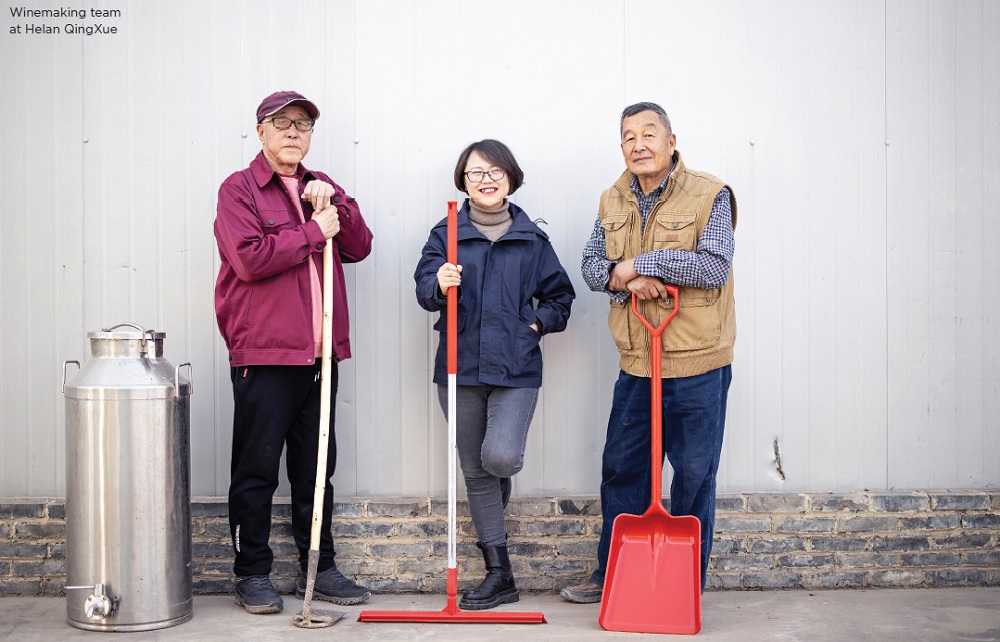
“At first [in 2005), we planted [marselan] on our experimental plot. But the soils were high in pH, and the berries came out too small,” Zhang says. “In 2015, we planted it again on a better site, with gravel soils.” The change of terroir worked, and now she produces a single varietal marselan.
In addition to marselan, Zhang also developed pinot noir. Her 2015 expression caught the attention of Jancis Robinson, who found it had a “nice balance of fruit and acidity” and gave it 17 points out of 20. Not content to rest on her laurels, Zhang shares, “The next variety I am going to try is tempranillo.”
THE WET SUMMERS OF SHANXI
Shangxi is a much smaller region compared to Ningxia and is particularly known for its cabernet. Situated 500km west of Beijing, Shanxi sports wet summers and freezing winters. “It warms up and cools down very quickly. We harvest mid-October and must prune the vines in early November before it starts to snow, “shares Lee Yean Yean, the Malaysian-born winemaker at Grace Vineyard.
Grace’s Tasya Reserve Marselan is celebrated for picking up one of the top awards at the Decanter competitions and influencing the varietal’s growth and acceptance.
Summer rains translate to disease, which can prove a nuisance for thin-skinned varietals like pinot noir. Marselan, on the other hand, is fairly disease resistant. “It is a strong variety. Over the years, we’ve had no problems with botrytis and powdery mildew,” Yean shares.
Yean says Grace Vineyard is committed to trying new varietals that adapt well to the Shanxi soils. The southern Italian robust aglianico was bottled recently, as was shiraz, which delivers a peppery expression.
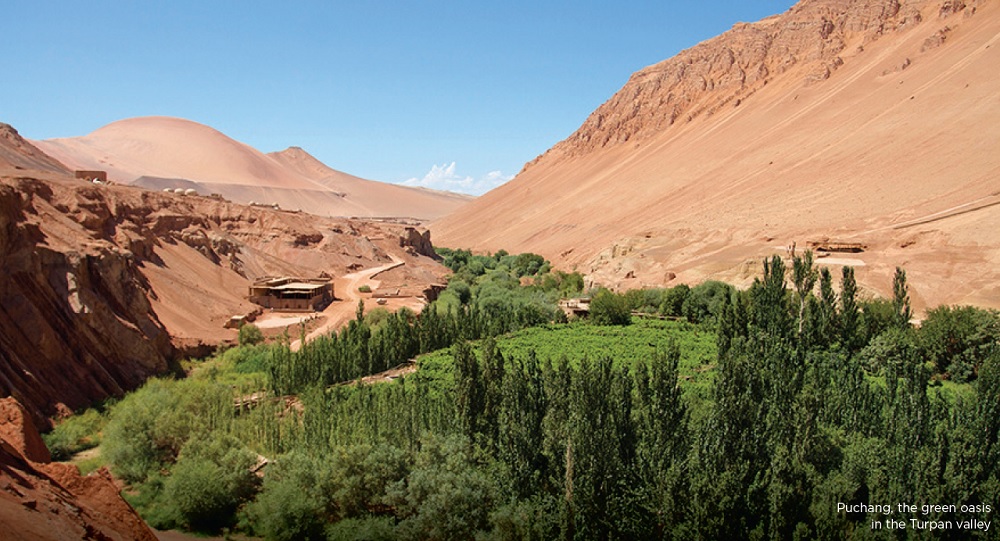
DESOLATE XINJIANG
In stark contrast to Shanxi, Xinjiang has no disease. The dry weather and low rainfall encourage pest-free organic farming. Water is sourced from the ice melts of Tianshan Mountain and freshwater Bosten lake.
Puchang Vineyard in Turpan Valley – a green oasis amid the Gobi Desert – champions ancient Georgian varietals saperavi and rkatsiteli, in addition to a muscat and local grapes. “I did not choose these varietals. Rkatsiteli was planted here centuries ago by nomads from Central Asia,” Loris Tartaglia says. The Italianborn head winemaker works in extreme weather and coaxes remarkably balanced wines. “I respect the grapes and keep the land as pure as possible,” he says.
Another notable organic producer, Tiansai, produces an impressive “Chablis-styled” chardonnay at 13% to 13.5% ABV, in addition to Bordeaux varietals. General manager Martin Shen says, “Our wine has significant purity and flavour intensity – this is something we are pursued for.”
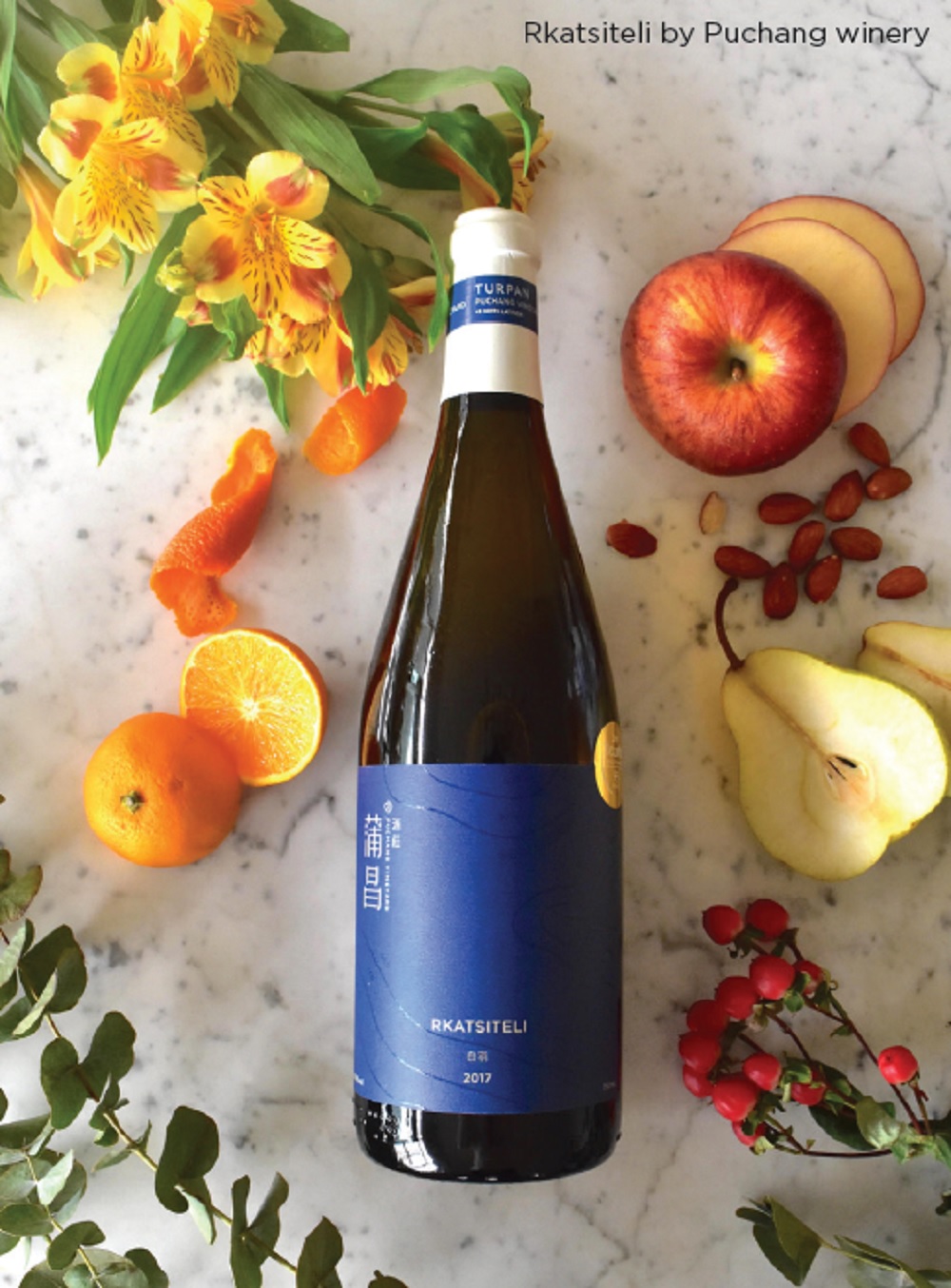
A THIRSTY NATION
China has attracted interest from the mighty and translated it into consultation and investments. Chateau Changyu-Moser XV (a partnership with Austrian winemaker Lenz Moser), LVMH’s Domaine Chandon in Ningxia and Chateau Lafite’s Domaine de Long Dai in Penglai, Shandong are among the notable ones.
In terms of exports, only a small percentage of wines make it to international markets, as national sales lay claim to 95 percent of the production. In the case of Grace Vineyard, Yean shares that 50 percent of their wine is consumed in Shanxi alone. However, exports are considered important by any producer seeking wider recognition and awareness, and Chinese wines are sold in the UK, Australia, Singapore, Hong Kong, and Canada.
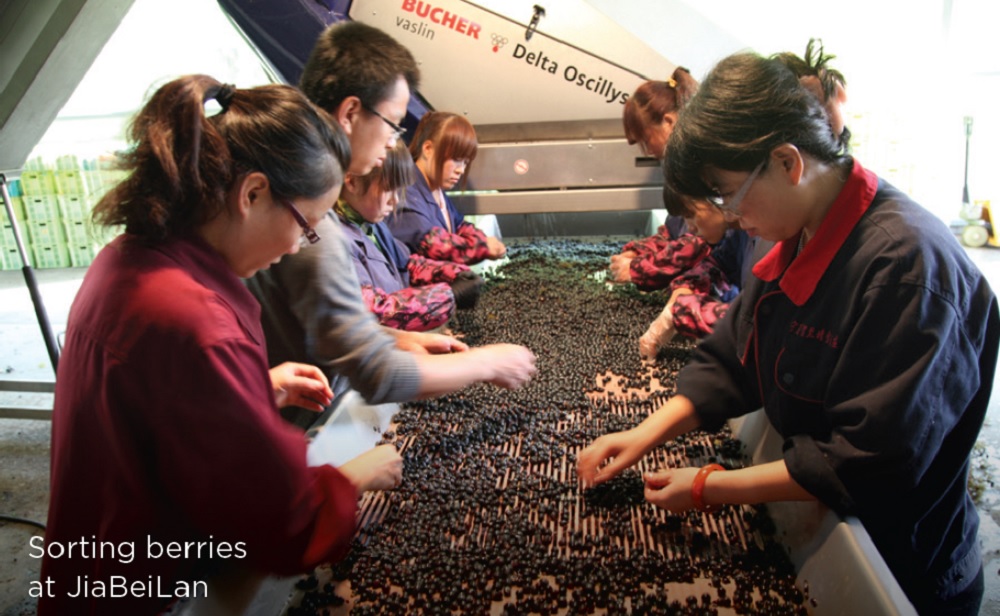
STILL IN ITS INFANCY
“Imagine following a region from scratch and witnessing the evolution in ten years,” Emilie Steckenborn says. As a wine consultant based in Beijing and founder of the Bottled in China podcast, she has witnessed China’s growth at close quarters.
“Technology has helped us improve wine quickly. Compared to Napa or any other emerging region in the 70’s, China has come up really fast, “she says. She refers to the education and knowledge of terroir, canopy management and temperature controls that young winemakers can access from France and Australia.
However, as with all emerging wine regions, there are problems. Quality is inconsistent and varies with vintage; there’s a shortage of experienced winemakers; terroirs need to be better matched with varietals; and there’s a glug of Chilean wine masquerading as Chinese at the inconspicuous low-end levels.
The final test for new terroirs is a “sense of place”. Ten years ago, Chinese wines tasted of inexperience. The current vintages are well made, with distinct characters of silky tannins and herbal tones coming through. But can a Penglai Cabernet stand apart from Ningxia’s? Some producers claim that terroir expressions are becoming apparent. At Helan QingXue, Zhang’s response was more measured: “Site expressive wines will take time.”
